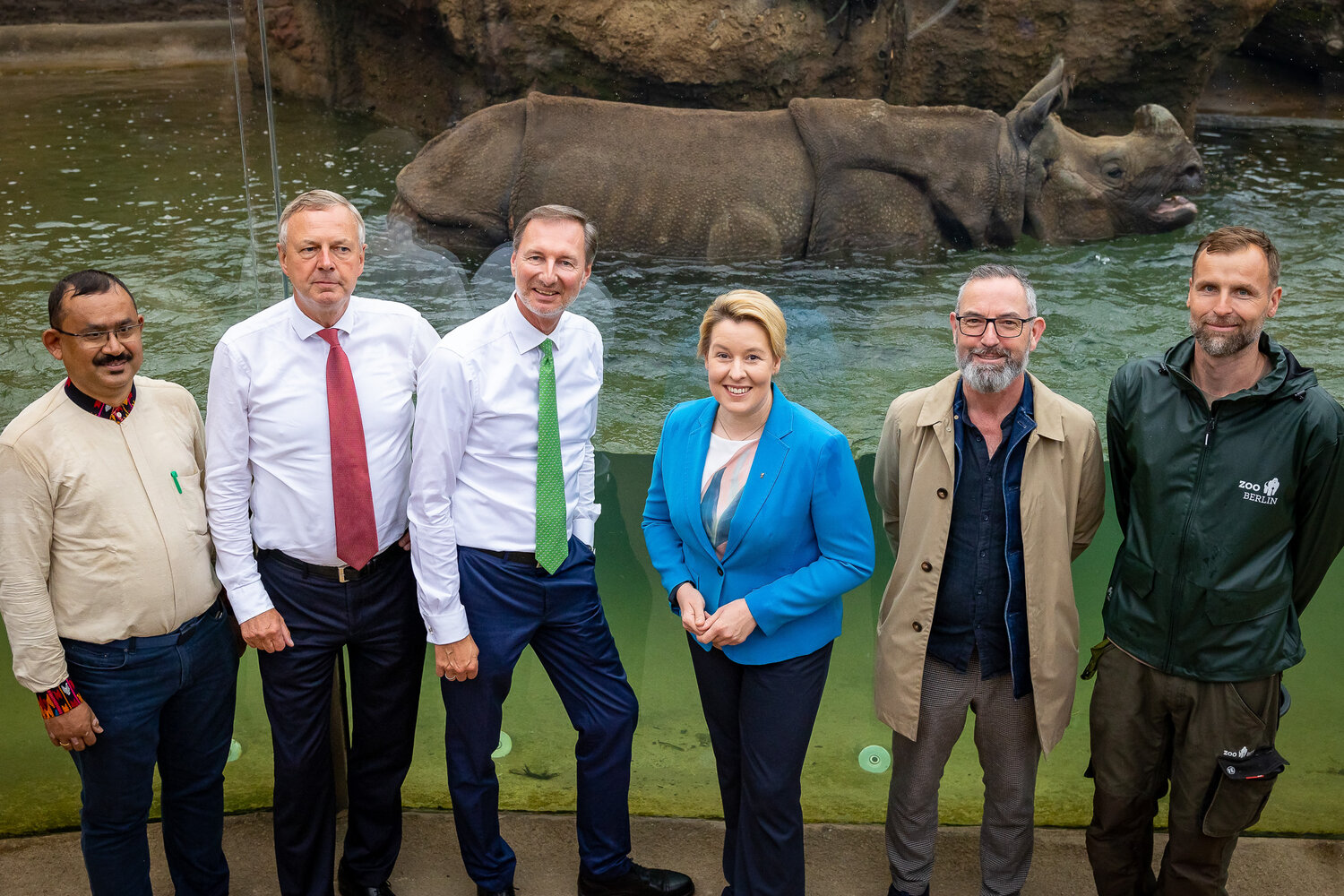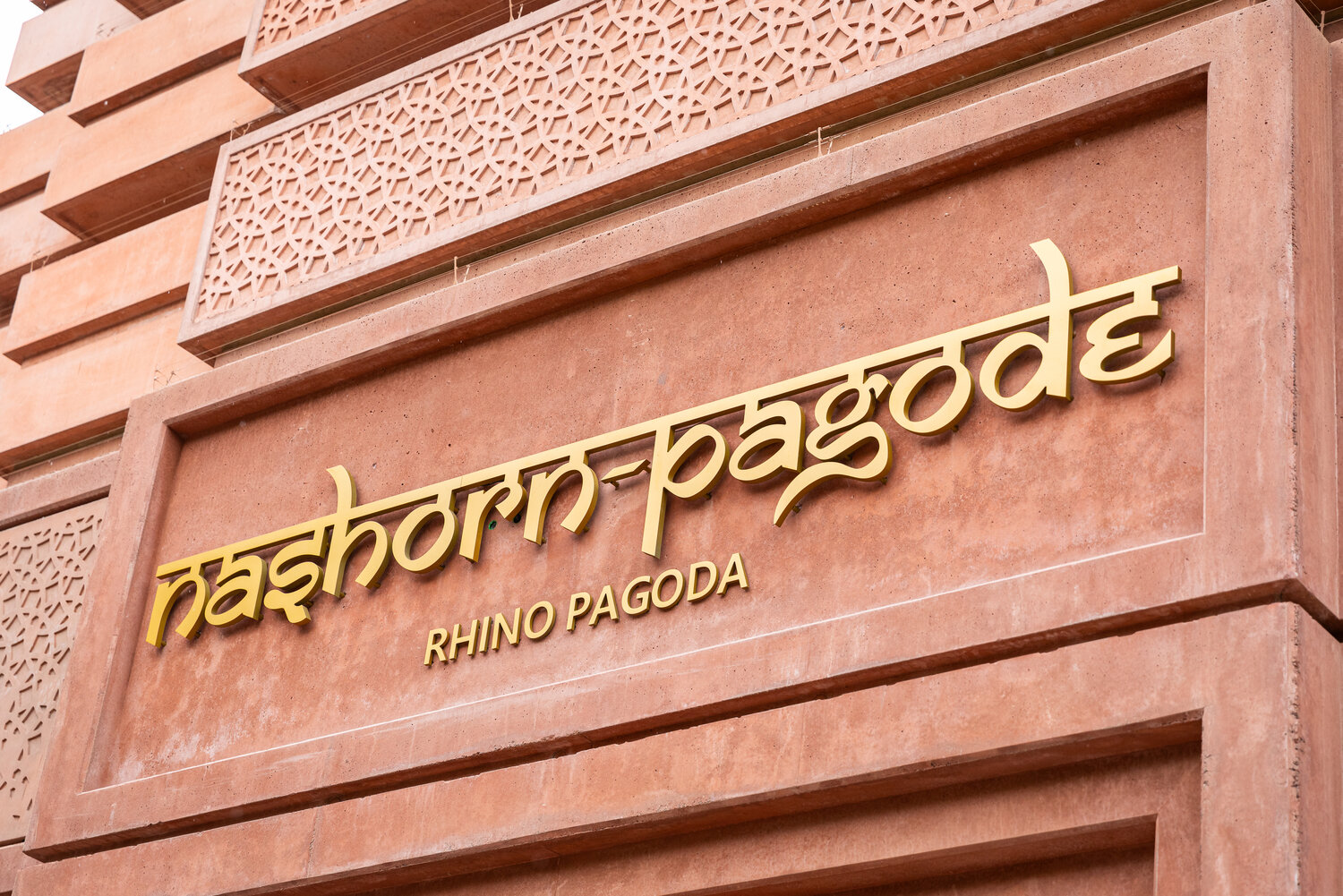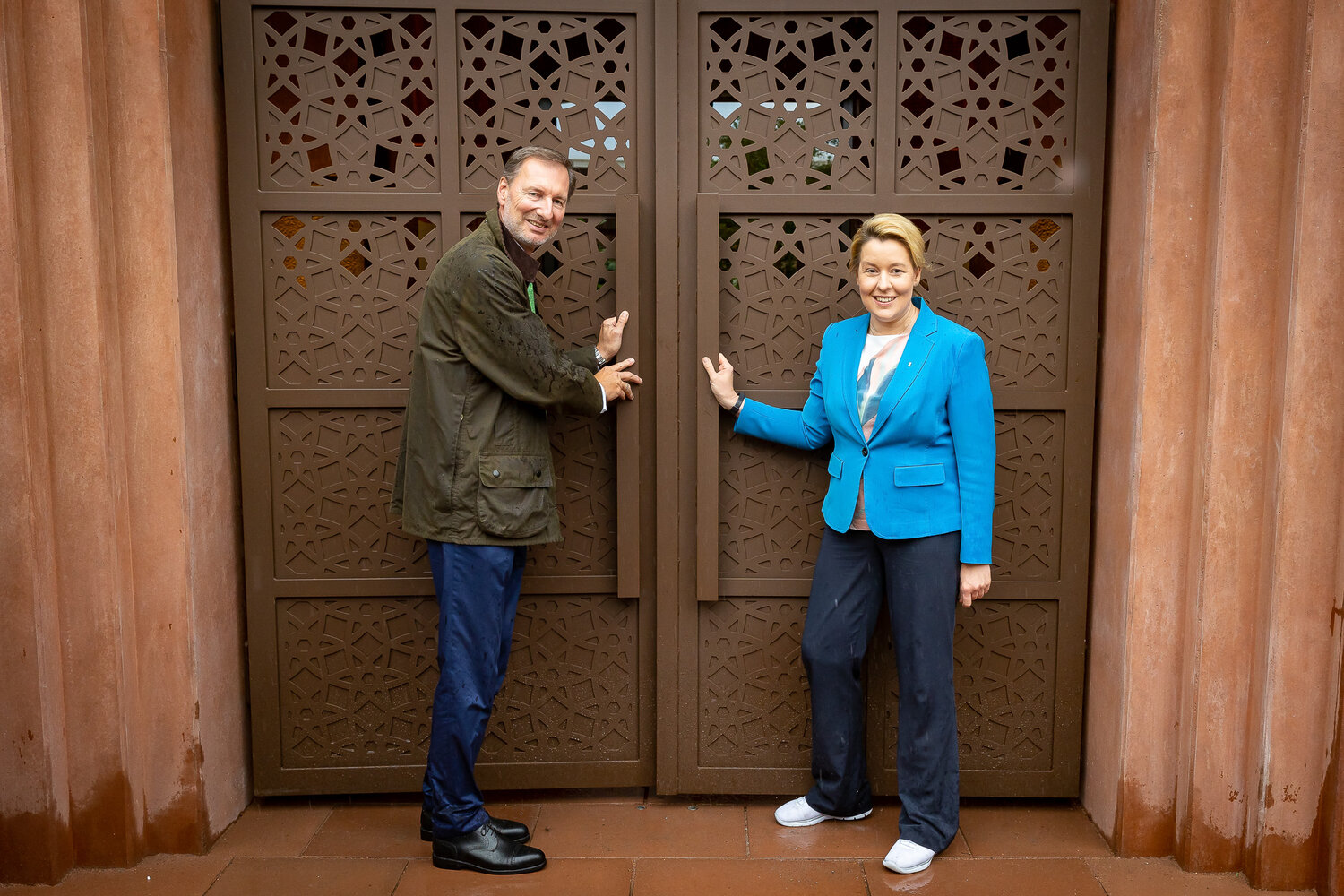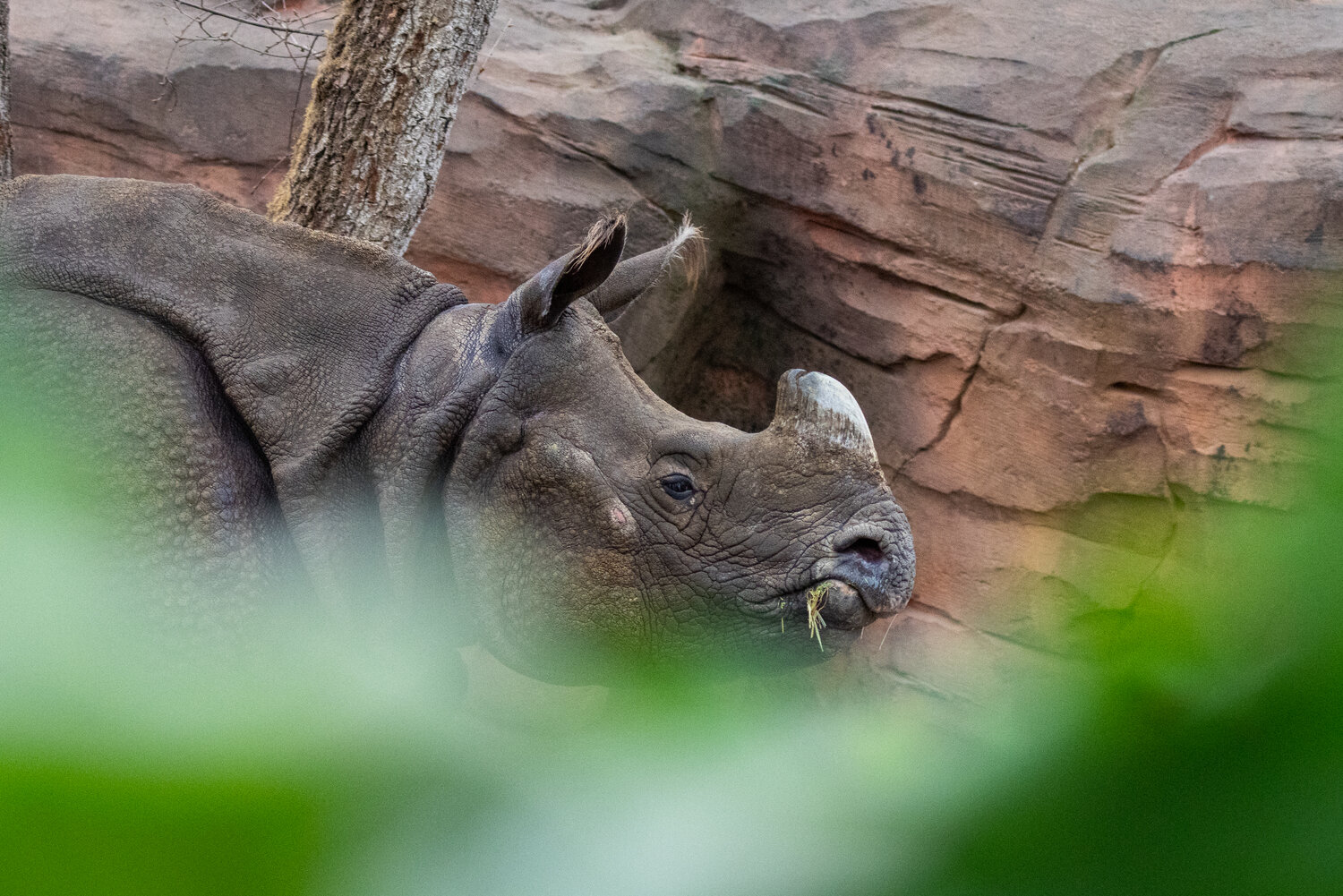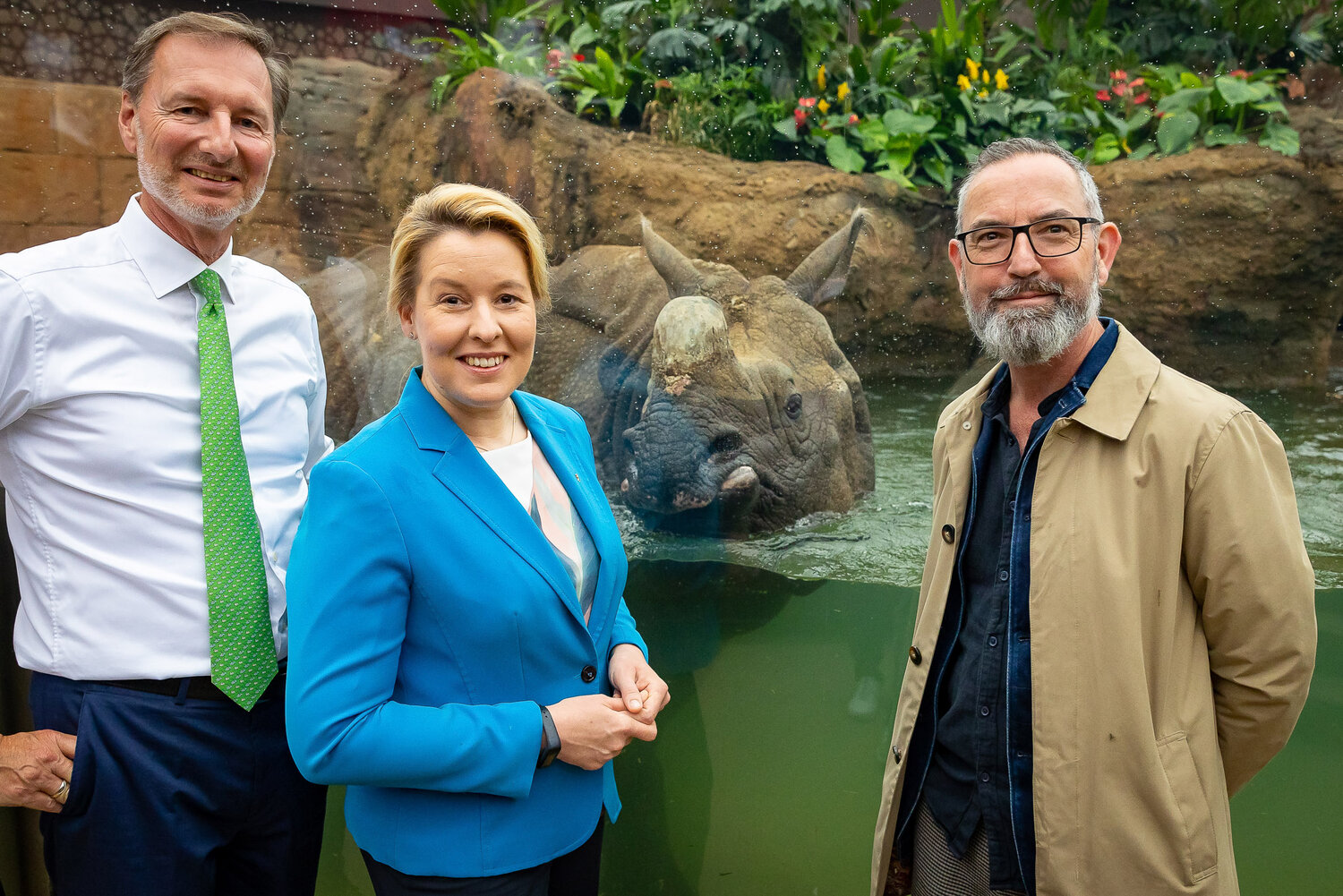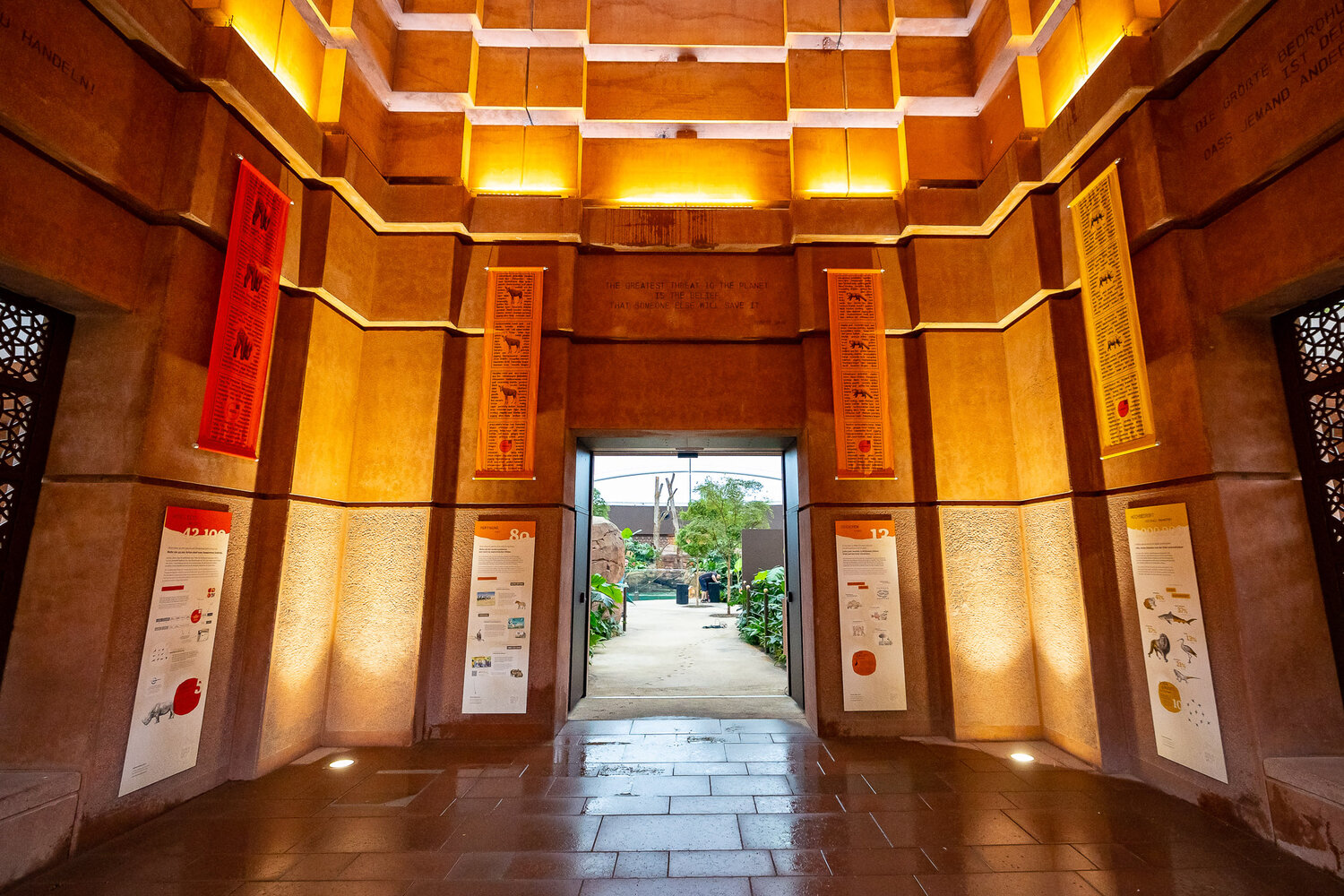“It’s not simple facts that change the way people think, but the moving stories behind those facts.”
Zoo and Tierpark Director Dr Andreas Knieriem
Following two years of construction work, an impressive monument to species conservation has now opened at Zoo Berlin. The new Rhino Pagoda pays tribute to one of the greatest conservation success stories in Asia: the preservation of the Indian rhinoceros. From 24 June, visitors to Zoo Berlin can watch Indian rhinoceroses (both above and below water), Visayan warty pigs, and lowland tapirs in a brand-new habitat close to the Löwentor entrance. The new structure also houses an exhibition on species conservation efforts here in Berlin and around the world.
“The Indian rhinoceros almost became extinct in the early 20th century, with fewer than 200 individuals left in the wild,” says Christian Kern, Zoological Director of Zoo and Tierpark Berlin. “However, thanks to extraordinary conservation measures, this majestic species could be saved – and with it an entire ecosystem.” The Indian rhinoceros is a so-called “umbrella species”: a charismatic animal species from whose protective measures many other, lesser-known animal and plant species benefit. Following a ban on rhinoceros hunting and the establishment of protected areas, Indian rhinoceros populations gradually recovered. “The Rhino Pagoda represents an important part of our mission to advance species protection efforts and raise public awareness of the dangers inherent in biodiversity loss – with the Indian rhinoceros serving as an excellent example,” explains Zoo and Tierpark Director Dr Andreas Knieriem. “We are taking a combined approach to securing the future of these animals. On the one hand, we have created a safe environment for the rhinos and their offspring here at Zoo Berlin. At the same time, we want to help people understand the threats facing these rhinos and foster a desire to protect them and other threatened species.” Zoo Berlin has been expanding its commitment to protecting endangered species in their natural habitats. Donations to Zoo Berlin are channelled into itsBerlin World Wild conservation programme, which helps rhinoceroses in India as well as many other species around the globe. “We are proud of the rhino’s success story,” says IUCN rhino expert Dr Bibhab Talukdar, founder and CEO of Indian wildlife NGO Aaranyak. “Last year, thanks to the proactive measures implemented by the state government, not a single rhino was poached in the state of Assam,” he continues. Aaranyak, which has a strong presence on the ground in Assam, complemented and assisted the efforts of government agencies. “Only with reliable partners such as Zoo Berlin can we continue to support government agencies in securing the future of the rhinoceros in India,” Talukdar adds. “We are very grateful for our allies in species conservation.”
For more information, visit: https://www.zoo-berlin.de/en/species-conservation/worldwide
At the grand opening of the Rhino Pagoda, Franziska Giffey, Senator for Economics, Energy and Public Enterprises, emphasised the importance of the Berlin Senate’s recent investments in Zoo and Tierpark Berlin: “A newly designed savannah habitat and giraffe walkway was recently opened at Tierpark Berlin, and now we have another highlight with the new Rhino Pagoda at the Zoo,” she said. “An investment of €15.4 million from the GRW funds has given Zoo Berlin this fabulous new landmark and a wonderful new home for the four Indian rhinos Inesh, Sanjay, Jhansi and Betty. The habitat is tailored to the needs of the animals and is sure to inspire the people of Berlin and our visitors from all over the world. The rhinoceros is one of the best-known representatives of endangered species. In the new animal house, visitors can get very close to the impressive creatures and even watch them underwater through a specially designed glass pane – a world-first. The new animal house thus offers a fascinating experience for visitors of all ages, while also making an important contribution to environmental education and species conservation. The Zoo and Tierpark attract large numbers of visitors from Berlin and beyond. The new attractions are sure to bolster tourism in the city and thus its economic development. These kinds of projects show how important the GRW funds are for Berlin: without them, construction of this wonderful new structure would not have been possible. I therefore take this opportunity to once again call upon the federal government to avoid making cuts to the GRW funds in the new federal budget.” The Rhino Pagoda is complemented by a specially commissioned artwork erected outside the entrance: Ein Horn (“One horn”) by French artist Adrien Missika.
A new highlight in the heart of the city
A close-to-nature swampy grass landscape has been created on a 14,000 m² site at Zoo Berlin, featuring numerous pools, waterfalls, showers and mud wallows. The animal house itself has a surface area of 2,000 m² and fulfils all the requirements of modern animal-keeping. Indian rhinoceroses, whose natural habitat has soft, marshy ground, require a special floor covering for their sensitive feet. A particularly soft material was therefore chosen for the flooring in both the indoor and outdoor areas. These rhinos spend a lot of time in the water, so the foursome at Zoo Berlin have been treated to a 5,000 m² “spa area” that provides behavioural enrichment, skin care and plenty of ways to cool off, with five swimming pools, three mud wallows, and showers. The other residents of the new animal house, which include seven Visayan warty pigs, also bring added interest for the rhinos and visitors alike – although the warty pigs can withdraw at any time to their private “pig lounge” if interaction with their heavyweight flatmates gets a bit too much. Other opportunities for pampering include deadwood trees and stumps that the animals can use to give their thick skin an invigorating rub.
Architect Kieran Stanley is proud of the overall result: “Architecturally, the sophisticated Rhino Pagoda pays a modern homage to the historic buildings of Zoo Berlin. The architecture and landscaping of this new mixed-species habitat are holistically integrated with the informative exhibition inside. We invite visitors to explore this replica of the animals’ natural habitat and hope that the close spatial and emotional proximity to these creatures effectively conveys the important message of species conservation.” The successful implementation of the project – which presented challenges in both its planning and its construction – is a direct result of the creative and respectful collaboration of everyone involved, with close consultation between dan pearlman Erlebnisarchitektur and Zoo Berlin. “As the tallest structure at Zoo Berlin, the 25-metre tower of the Rhino Pagoda serves as a new Zoo landmark that is visible from far beyond its gates,” says Supervisory Board Chairman Frank Bruckmann. “It gives our visitors the unique opportunity to observe Indian rhinos up close and learn more about their way of life and the challenges they face.” Inside the Rhino Pagoda, visitors embark on a journey to the homeland of the fascinating Indian rhinoceros, learn more about its natural habitat in northeastern India, and address some of the most important questions for the future of planet Earth: What are the consequences of the loss of biodiversity? Is there still a glimmer of hope? How can I make my own contribution to species conservation?
Facts and figures
- 4 Indian rhinoceroses (Rhinoceros unicornis)
Inesh, born 8 Sept. 2020 (from West Midland Safari Park) Sanjay, born 1 March 2017 (from Edinburgh Zoo)
Jhansi, born 20 July 1990 (from Dierenrijk Europa
Betty, born 21 Jan. 1995 (already living at Zoo Berlin)
- 2 lowland tapirs (Tapirus terrestris)
Pablo, born 6 Nov. 2009
Ines, born 5 Dec. 2006
- 7 Visayan warty pigs (Sus cebifrons negrinus)
Buildings and installations
- Total project budget: €23 million
- €18 million from the joint federal/Land Scheme for the Improvement of Regional Economic Structures (GRW) (90% subsidies and 10% own funds)
- €5 million from own funds for professional fees
- Project started: November 2017 (plans) / October 2020 (demolition of existing building)
- Construction started: May 2022 (shell) / Sept. 2021 (cornerstone)
- More than 60 companies involved in planning and execution, including:
- Project participants, planning:
- Building and outdoor facility planning: dan pearlman Erlebnisarchitaktur GmbH
- Construction supervision: emproc Bauprojektmanagement GmbH & Co. KG
- Building services: b.i.g. bechtold Ingenieurgesellschaft mbH
- Project participants, construction:
- Shell construction: Glass Ingenieurbau Leipzig GmbH
- Metal construction, fence and gate systems: Metallbau OTT GmbH
- Gardening and landscaping: Flute & Uszkureit
- Groundwork: 600 m³ of excavated soil; 14 piles with lengths of 12–14 metres, no floor slabs in the indoor area for better foot health
- Pools: 8 in total; water depth ranges from 1.2 m (rhinos) to 1.5 m (tapirs)
- The 25 m tower weighs 400 tonnes, modular structure of 68 stacked sections on 18 levels
- World-first 9-metre-long, 70-mm-thick underwater glass pane for rhino observation, consisting of up to 5 layers of laminated safety glass (460 m² in total)
- Roof area: approx. 2,050 m², with lush greenery covering approx. 300 m²; roof-mounted solar panels for heating water
- Circular ETFE roof with underlying steel structure, span of 37 metres, incorporating 2 tonnes of translucent plastic sheeting (foil) to let in daylight
- Red concrete of the tower resembles Agra sandstone from the rhinos’ homeland in northern India; specially created ornamentation evokes the lotus blossom as a recurring and connecting design element
